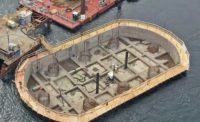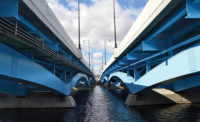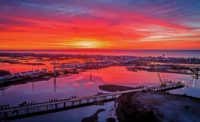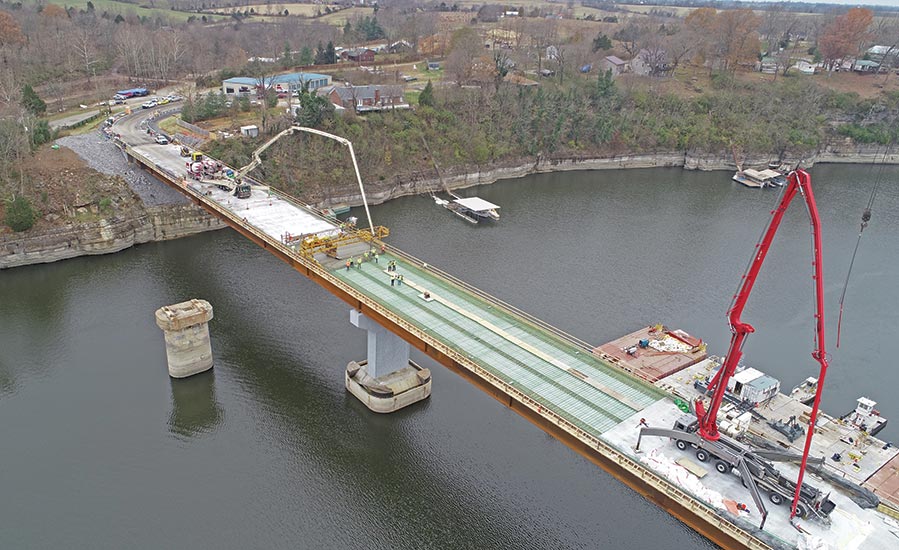ENR Midwest’s 2019 Best Projects
Kentucky 152 Bridge Replacement is Both a Bridge and Safety Standout

The $31.5-million Kennedy Mill Bridge replaced a 94-year-old structure that had endured numerous closures and repairs in its final years.
Photos by Noah Holladay and Kevin Buch, courtesy Walsh Construction

The 826-ft-long, two-span continuous steel plate girder bridge required unique engineering and constructibility methods due to the lake’s 200 ft depth and its large summertime volume of recreational activity.

The structure’s 275-ft long piers were crafted in 60-ft sections, then incrementally lowered to solid rock via four 300-ton strand jacks. This solution facilitated full inspection of the piers’ cast-in-place braces and casing welds before the sections were lowered.



Kentucky 152 Bridge Replacement Over Herrington Lake
Harrodsburg, Ky.
Awards of Merit
Owner: Kentucky Transportation Cabinet
General Contractor: Walsh Construction Co.
Lead Design Firm: DLZ Corp.
Construction Engineer: Genesis Structures Inc.
Divers: Marine Solutions Inc.
Rodbuster and SIP Decking Subcontractor: BarTie
Completed in just 20 months, the $31.5-million Kennedy Mill Bridge (Kentucky 152) safely connects Kentucky’s Mercer and Garrard counties across Herrington Lake, replacing a 94-year-old, triple-span truss structure that had endured numerous closures and repairs in its final years. The 826-ft-long, two-span continuous steel plate girder bridge required unique engineering and constructibility methods due to the lake’s 200 ft depth and its large summertime volume of recreational activity.
Instead of utilizing a conventional underwater construction approach for what would be a massive foundation system, the project team’s innovative strategy shifted a large part of the work above the surface. Working from barges, the team installed underwater rock anchors up to 38 ft below the lake bottom with a down rigger system to carry the anchor cables. With this system, the anchor cables remained a minimum of 20 ft under water, allowing safe, unimpeded passage for other boat traffic.
The structure’s 275-ft long piers were crafted in 60-ft sections, then incrementally lowered to solid rock via four 300-ton strand jacks. This approach eliminated conventional hoist work that typically requires multiple crane picks. The foundation weighs nearly 1.9 million lb.
Minimizing underwater construction reduced the costs associated with divers as well as a host of safety hazards, such as tangled air supply hoses and handling ropes, shocks from underwater welding, depth-related nitrogen narcosis and other risks. The solution also facilitated full inspection of the piers’ cast-in-place braces and casing welds before the sections were lowered, eliminating another hazardous underwater task.
Frequent torrential rains caused wide fluctuations in the lake’s surface elevation, reaching near-record levels that at one point forced a three-month shutdown of foundation operations. Turning the interruption’s negatives into opportunities, the project team pivoted to focus on other tasks such as excavation and installation of a gravity wall, installation of drilled shafts at one abutment and completing demolition of the existing bridge.
Weather interruptions were used to preassemble materials for future deck operations, accelerating construction once weather improved. The idea was to do more than simply regain lost time. The team’s revised construction strategy called for delivering the new structure nearly a year ahead of schedule.
The goal was achieved just before Christmas 2018 when the new bridge was opened to traffic, having been completed 11 months ahead of schedule with no significant quality-related issues. The 24-in.-tall cast-in-place superstructure barrier wall is topped with a hot-dipped galvanized steel tube railing to provide passersby views of the lake and surrounding landscape.
The fast-track approach would not compromise safety as all workers were empowered to halt work so that potential safety issues could be assessed and rectified as needed. Strong relationships between field crews and project management allowed honest discussions and constructive criticism that drastically decreased exposure to hazards. The project experienced no recordable incidents or lost-time injuries over more than 104,000 staff hours.
Back to "35 Best Projects Showcase Midwest Design, Construction Innovation"







